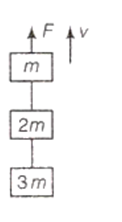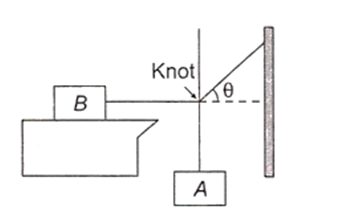 Multiple Choice Questions
Multiple Choice QuestionsThree blocks of masses 4 kg, 2 kg, 1 kg respectively are in contact on a frictionless table as shown in the figure. If a force of 14 N is applied on the 4 kg block, the contact force between the 4 kg and the 2 kg block will be

2 N
6 N
8 N
14 N
Three blocks with masses m, 2m and 3m are connected by strings, as shown in the figure. After an upward force F is applied on block m, the masses move upward at constant speed v. What is the net force on the block of mass 2m ? (g is the acceleration due to gravity)

Zero
2 mg
3 mg
6 mg
The upper half of an inclined plane of inclination θ is perfectly smooth while lower half is rough. A block starting from rest at the top of the plane will again come to rest at the bottom, if the coefficient of friction between the block and lower half of the plane is given by
µ = 2 tan θ
µ = tan θ
A smooth massless string passes over a smooth fixed pulley. Two masses m1 and m2, (m1 > m2) are tied at the two ends of the string. The masses are allowed to move under gravity starting from rest. The total external force acting on the two masses is
(m1 + m2) g
(m1 − m2) g
To determine the coefficient of friction between a rough surface and a block, the surface is kept inclined at 45° and the block is released from rest. The block takes a time t in moving a distance d. The rough surface is then replaced by a smooth surface and the same experiment is repeated. The block now takes a time t/2 in moving down the same distance d. The coefficient of friction is
3/4
5/4
1/2
Block B lying on a table weighs W. The coefficient of static friction between the block and the table is µ. Assume that the cord between B and the knot is horizontal. The maximum weight of the block A for which the system will be stationary is

µW tan θ
µW sin θ
